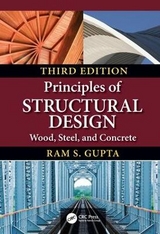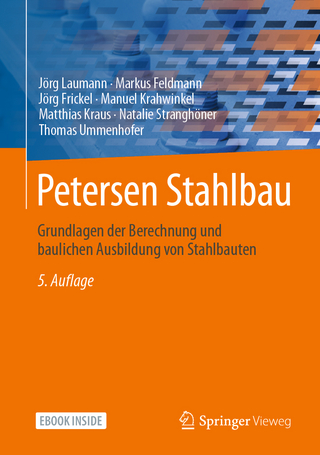
Principles of Structural Design
Crc Press Inc (Verlag)
978-1-4665-5231-9 (ISBN)
- Titel erscheint in neuer Auflage
- Artikel merken
What’s New in This Edition:
Reflects all the latest revised codes and standards
The text material has been thoroughly reviewed and expanded, including a new chapter on concrete design
Suitable for combined design coursework in wood, steel, and concrete
Includes all essential material—the section properties, design values, reference tables, and other design aids required to accomplish complete structural designs according to the codes
This book uses the LRFD basis of design for all structures
This updated edition has been expanded into 17 chapters and is divided into four parts. The first section of the book explains load and resistance factor design, and explores a unified approach to design. The second section covers wood design and specifically examines wood structures. It highlights sawn lumber, glued laminated timber, and structural composite/veneer lumber. The third section examines steel structures. It addresses the AISC 2010 revisions to the sectional properties of certain structural elements, as well as changes in the procedure to design the slip-critical connection. The final section includes a chapter on T beams and introduces doubly reinforced beams.
Principles of Structural Design: Wood, Steel, and Concrete, Second Edition was designed to be used for joint coursework in wood, steel, and concrete design.
Ram S. Gupta earned a master’s in engineering from the Indian Institute of Technology (IIT), Roorkee, India, and a PhD from Polytechnic University, New York. He is a registered professional engineer in Rhode Island and Massachusetts, and is currently working as a professor of engineering at Roger Williams University (RWU), Bristol, Rhode Island. Dr. Gupta is president of Delta Engineers Inc., a Rhode Island-based consulting company. Besides contributing to a very large number of research papers, Dr. Gupta has authored three books including Principles of Structural Design: Wood, Steel, and Concrete (Taylor & Francis Group, Boca Raton, FL, 2010).
Section I Design Loads
Design Criteria
Classification of Buildings
Building Codes
Standard Unit Loads
Tributary Area
Working Stress Design, Strength Design, and Unified Design of Structures
Elastic and Plastic Designs
Combinations of Loads
Other Loads
Continuous Load Path for Structural Integrity
Problems
Primary Loads: Dead Loads and Live Loads
Dead Loads
Live Loads
Floor Live Loads
Other Provisions for Floor Live Loads
Roof Live Loads, Lr
Problems
Snow Loads
Introduction
Minimum Snow Load for Low-Slope Roofs
Balanced Snow Load
Rain-on-Snow Surcharge
Partial Loading of the Balanced Snow Load
Unbalanced across the Ridge Snow Load
Snow Drift from a Higher to a Lower Roof
Sliding Snow Load on Lower Roof
Sliding Snow Load on Separated Structures
Problems
Wind Loads
Introduction
Definition of Terms
Procedures for MWFRS
Simplified Procedure for MWFRS for Low-Rise Buildings
Procedures for Components and Cladding
Simplified Procedure for Components and Cladding for
Low-Rise Buildings
Problems
Earthquake Loads
Seismic Forces
Seismic Design Procedures
Definitions
Ground Motion Response Accelerations
Importance Factor, I
Seismic Design Categories
Exemptions from Seismic Designs
Equivalent Lateral Force Procedure to Determine Seismic Force
Distribution of Seismic Forces
Design Earthquake Load
Soil-Structure Interaction
Problems
Section II Wood Structures
Wood Specifications
Engineering Properties of Sawn Lumber
Reference Design Values for Sawn Lumber
Adjustments to the Reference Design Values for Sawn Lumber
Load Resistance Factor Design with Wood
Structural Glued Laminated Timber
Reference Design Values for Glued Laminated Timber
Adjustment Factors for Glued Laminated Timber
Structural Composite Lumber
Summary of Adjustment Factors
Problems
Flexure and Axially Loaded Wood Structures
Introduction
Design of Beams
Bending Criteria of Design
Beam Stability Factor, CL
Shear Criteria
Deflection Criteria
Creep Deflection
Bearing at Supports
Design of Axial Tension Members
Design of Columns
Column Stability Factor, CP
Design for Combined Bending and Compression
Problems
Wood Connections
Types of Connections and Fasteners
Dowel-Type Fasteners (Nails, Screws, Bolts, Pins)
Yield Limit Theory for Laterally Loaded Fasteners
Yield Mechanisms and Yield Limit Equations
Reference Design Values for Lateral Loads (Shear Connections)
Reference Design Values for Withdrawal Loads
Adjustments of the Reference Design Values
Nail and Screw Connections
Bolt and Lag Screw Connections
Problems
Section III Steel Structures
Tension Steel Members
Properties of Steel
Provisions to Design Steel Structures
Unified Design Specifications
Design of Tension Members
Tensile Strength of Elements
Block Shear Strength
Design Procedure for Tension Members
Problems
Compression Steel Members
Strength of Compression Members or Columns
Local Buckling Criteria
Flexural Buckling Criteria
Effective Length Factor for Slenderness Ratio
Limit States for Compression Design
Nonslender Members
Single-Angle Members
Built-Up Members
Slender Compression Members
Use of the Compression Tables
Problems
Flexural Steel Members
Basis of Design
Nominal Strength of Steel in Flexure
Lateral Unsupported Length
Fully Plastic Zone with Adequate Lateral Support
Inelastic Lateral Torsional Buckling Zone
Modification Factor Cb
Elastic Lateral Torsional Buckling Zone
Noncompact and Slender Beam Sections for Flexure
Compact Full Plastic Limit
Noncompact Flange Local Buckling
Slender Flange Local Buckling
Summary of Beam Relations
Design Aids
Shear Strength of Steel
Beam Deflection Limitations
Problems
Combined Forces on Steel Members
Design Approach to Combined Forces
Combination of Tensile and Flexure Forces
Combination of Compression and Flexure Forces: The
Beam-Column Members
Braced Frame Design
Magnification Factor for Sway, B2
K Values for Unbraced Frames
Unbraced Frame Design
Open-Web Steel Joists
Joist Girders
Problems
Steel Connections
Types of Connections and Joints
Bolted Connections
Specifications for Spacing of Bolts and Edge Distance
Bearing-Type Connections
Slip-Critical Connections
Tensile Load on Bolts
Combined Shear and Tensile Forces on Bolts
Welded Connections
Groove Welds
Fillet Welds
Strength of Weld
Frame Connections
Shear or Simple Connection for Frames
Single-Plate Shear Connection for Frames
Moment-Resisting Connection for Frames
Problems
Section IV Reinforced Concrete Structures
Flexural Reinforced Concrete Members
Properties of Reinforced Concrete
Compression Strength of Concrete
Design Strength of Concrete
Strength of Reinforcing Steel
Load Resistance Factor Design Basis of Concrete
Reinforced Concrete Beams
Derivation of the Beam Relations
Strain Diagram and Modes of Failure
Balanced and Recommended Steel Percentages
Minimum Percentage of Steel
Strength Reduction Factor for Concrete
Specifications for Beams
Analysis of Beams
Design of Beams
One-Way Slab
Specifications for Slabs
Analysis of One-Way Slab
Design of One-Way Slab
Problems
Doubly and T Reinforced Concrete Beams
Doubly Reinforced Concrete Beams
Analysis of Doubly Reinforced Beams
Design of Doubly Reinforced Beams
Monolithic Slab and Beam (T Beams)
Analysis of T Beams
Design of T Beams
Problems
Shear and Torsion in Reinforced Concrete
Stress Distribution in Beam
Diagonal Cracking of Concrete
Strength of Web (Shear) Reinforced Beam
Shear Contribution of Concrete
Shear Contribution of Web Reinforcement
Specifications for Web (Shear) Reinforcement
Analysis for Shear Capacity
Design for Shear Capacity
Torsion in Concrete
Provision for Torsional Reinforcement
Problems
Compression and Combined Forces Reinforced Concrete Members
Types of Columns
Strength of Spirals
Specifications for Columns
Analysis of Axially Loaded Columns
Design of Axially Loaded Columns
Short Columns with Combined Loads
Effects of Moment on Short Columns
Characteristics of the Interaction Diagram
Application of the Interaction Diagram
Analysis of Short Columns for Combined Loading
Design of Short Columns for Combined Loading
Long or Slender Columns
Problems
Bibliography
Appendices
Index
| Zusatzinfo | approx 467 equations; 137 Tables, black and white; 150 Illustrations, black and white |
|---|---|
| Verlagsort | Bosa Roca |
| Sprache | englisch |
| Maße | 178 x 254 mm |
| Gewicht | 1137 g |
| Themenwelt | Technik ► Bauwesen |
| Technik ► Bergbau | |
| ISBN-10 | 1-4665-5231-X / 146655231X |
| ISBN-13 | 978-1-4665-5231-9 / 9781466552319 |
| Zustand | Neuware |
| Haben Sie eine Frage zum Produkt? |
aus dem Bereich



